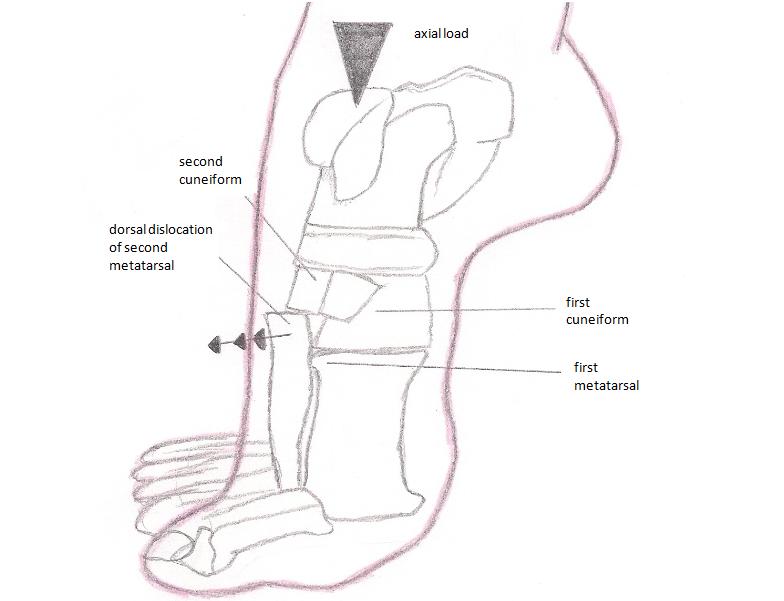What Is a Lisfranc Injury?
New York Jets receiver Santonio Holmes recently suffered a season-ending Lisfranc injury. Houston Texans QB Matt Schaub sustained the same injury last season. What is this injury and why is it sidelining athletes for entire seasons? (Check out STACK’s Injuries landing page.)
Lisfranc Injury Definition
A Lisfranc injury, named after Jacques Lisfranc, the French surgeon who first described it (in 1815), is an injury to the midfoot (as illustrated to the right). The injury occurs when there is a fracture and dislocation of the bones that form the arch of the foot, or a sprain to their ligament support structure.
Common Causes
Lisfranc injuries typically occurs when the ball of the foot is planted and a sudden twist occurs. This happens when simultaneously changing directions and getting tackled, as pictured below.
Other common causes include car accidents and falls from height. A minor Lisfranc injury can be sustained from slamming the foot into the ground, as when unexpectedly stepping into a hole. Lisfranc injuries are not all that common. In a study of 750 patients with foot injuries in a Finnish clinic, only nine percent were true Lisfranc injuries.
Performance Effects
A Lisfranc injury limits strength of the arch when standing, and especially when running or jumping. It’s also extremely painful, since the midfoot is heavily involved in stabilizing the foot during athletic movements, or even simply when walking.
Attempting to play a sport with this injury would be like trying to land an airplane that is missing a wheel—next to impossible. Instability in the midfoot area must be corrected before returning to play.
Outlook
As in the cases of Holmes and Schaub, a true Lisfranc injury will end a season and invariably require surgery to correct. Even a Lisfranc ligament sprain takes six weeks of non-weight bearing immobilization in a boot before rehab can even be started.
The good news is that with time and proper medical care, athletes can fully return to play after this injury.
Photo: sbnation.com
Source:
Vuori JP, Aro HT, Department of Surgery, University of Turku, Finland. “Lisfranc joint injuries: trauma mechanisms and associated injuries.” Journal of Trauma, 1993 Jul; 35(1):40-5.
RECOMMENDED FOR YOU
MOST POPULAR
What Is a Lisfranc Injury?
New York Jets receiver Santonio Holmes recently suffered a season-ending Lisfranc injury. Houston Texans QB Matt Schaub sustained the same injury last season. What is this injury and why is it sidelining athletes for entire seasons? (Check out STACK’s Injuries landing page.)
Lisfranc Injury Definition
A Lisfranc injury, named after Jacques Lisfranc, the French surgeon who first described it (in 1815), is an injury to the midfoot (as illustrated to the right). The injury occurs when there is a fracture and dislocation of the bones that form the arch of the foot, or a sprain to their ligament support structure.
Common Causes
Lisfranc injuries typically occurs when the ball of the foot is planted and a sudden twist occurs. This happens when simultaneously changing directions and getting tackled, as pictured below.
Other common causes include car accidents and falls from height. A minor Lisfranc injury can be sustained from slamming the foot into the ground, as when unexpectedly stepping into a hole. Lisfranc injuries are not all that common. In a study of 750 patients with foot injuries in a Finnish clinic, only nine percent were true Lisfranc injuries.
Performance Effects
A Lisfranc injury limits strength of the arch when standing, and especially when running or jumping. It’s also extremely painful, since the midfoot is heavily involved in stabilizing the foot during athletic movements, or even simply when walking.
Attempting to play a sport with this injury would be like trying to land an airplane that is missing a wheel—next to impossible. Instability in the midfoot area must be corrected before returning to play.
Outlook
As in the cases of Holmes and Schaub, a true Lisfranc injury will end a season and invariably require surgery to correct. Even a Lisfranc ligament sprain takes six weeks of non-weight bearing immobilization in a boot before rehab can even be started.
The good news is that with time and proper medical care, athletes can fully return to play after this injury.
Photo: sbnation.com
Source:
Vuori JP, Aro HT, Department of Surgery, University of Turku, Finland. “Lisfranc joint injuries: trauma mechanisms and associated injuries.” Journal of Trauma, 1993 Jul; 35(1):40-5.















